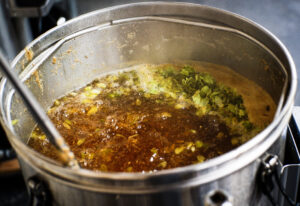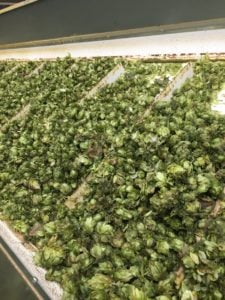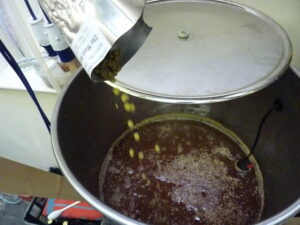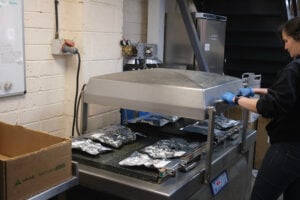Brew With Us ESSENTIALS – whirlpooling and dry hopping

A (less) bitter pill to swallow
We love hop flavour – but we can only take so much bitterness.
So how can we pack more hops in without turning our beer into tooth polish?
Many of the oils and flavour compounds in hops are sensitive to heat. Alpha acids are a good example: we know that when we boil hops, the alpha acids isomerise, becoming noticeably more bitter (and counting towards the IBU level). If you want to use less hops to achieve the same bitterness, you can start with higher AA% hop varieties, or boil for longer. It follows that if you use lower AA% varieties, or boil for less long, you’ll get less bitterness.
Other compounds, though, are volatile and are destroyed by high heat over time… so to get these flavours out you can choose not to boil the hops at all – either adding them after the boil is finished or to the cooled wort in the fermenter.
That’s a bit steep
Steeping hops in wort after the boil is a very common technique with a couple of different variations.

A flame out addition is performed pretty much immediately at the end of the boil. Turn off the heat (flame out) and begin chilling, then add your hops. In practice this means the hops are added at temperatures of around 85-90°C and are in contact with the wort for as long as it takes for you to chill to pitching temperatures.
If you want a longer contact time, you can leave off chilling the wort. Many brewers hold the temperature at around 80°C for around thirty minutes to let the hop flavours extract. This is called a hop stand.
When working with pellet hops, it’s important to stir or recirculate the wort at the end of the boil. This creates a vortex – a whirlpool – that collects the hop debris in the middle of your kettle, away from the outlet valve. Throwing in hops at this point is called a whirlpool addition.
The differences between these terms are quite loose – a flame out addition is pretty much the same as a really short hop stand, and you could equally choose to whirlpool for half an hour to get the same effect as a hop stand. Whichever technique you use, different temperatures and contact times can produce different effects. Experiment to find your favourite combination!
Dry hopping
Hops added to beer in the fermenter are called dry hops. This was traditionally done with beers intended for long storage – the extra hops helped stop the beer going off while it aged. Brewers and drinkers came to enjoy the “fresh from the bag” hop flavour this added to young beer, and nowadays dry hopping is usually done specifically for flavour.

Of course, pretty much all the hops we add to a beer are dry… the flowers are carefully dried and used either whole as is or processed into pellets. This means hops are available to brewers all year round.
Wet hops do exist, though! Fresh hop flowers can be used straight from the plant without drying them first – but these are only available immediately after the hop harvest. Brewers often make special beers with these ultra-fresh hops, and these are usually called “green hop” or “wet hop” beers.
Dry hopping can be as simple as throwing extra hops into a keg of finished beer – making sure you can get the beer out without the hops clogging the keg outlet. A more common method is to dose hop pellets directly into the fermenter. The hop pellets will dissolve over time so you can rack beer off the top without picking up any particles. Cold crashing – reducing the temperature of your beer to 3°C or less – also helps the hops drop out of suspension.
Dry hopping won’t add any IBUs as there is no heat to isomerise the alpha acids, but raw hops are still bitter and astringent due to flavour compounds called polyphenols. Too much of this astringency in your beer is called hop burn. Lowering the temperature of your beer to 10-12°C before dry hopping and not leaving the hops in for more than 48 hours can reduce the level of polyphenols and hop burn.
Typically, dry hopping is done after fermentation is finished, but you can add hops to the fermenter at any time. The flavours released by hops while yeast is actively fermenting can be different, and there is a school of thought that the yeast will actually convert some hop flavour compounds into new forms. This is called biotransformation and is a hot topic in NEIPA and hazy IPA brewing! Of course, adding hops while fermentation is still active means the hops will likely be in contact with the beer for more than 48 hours, and at relatively warm temperatures. This increases the risk of hop burn, which might drown out delicate flavours from biotransformation, so the process is a delicate balancing act.

Ah, oxygen, my old enemy
Oxidation will destroy hop flavour compounds just as quickly as heat. If you cut open an apple and leave it on the side, in just half an hour it will have turned very brown. The same staling reaction happens with hops – if you’ve ever seen a greyish-brown pint of NEIPA, this is why – and many of the volatile flavours are lost. So preventing oxygen exposure to hops is very important.

This begins with how the hops are stored. We flush our hop pellets with nitrogen and vacuum seal them in foil bags to keep them safe from both light and oxygen. We also keep them refrigerated up to the moment they are sent out: cold temperatures slow the staling reactions.
We recommend you keep your hop packets cold until you’re ready to use them – hops actually freeze really well and can be used straight from the freezer. If you can, it’s a good idea to use a kitchen vacuum sealer to pack up any leftovers from an open packet. This will help keep the hops in peak condition until you’re next ready to use them.
Let’s hop across the pond
Did someone say “dank”?
Our hop tour resumes as we visit the USA and the New World!



